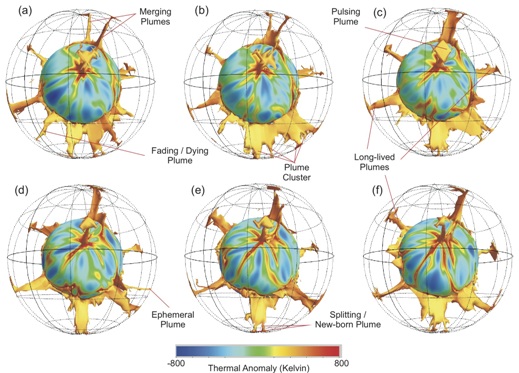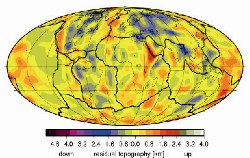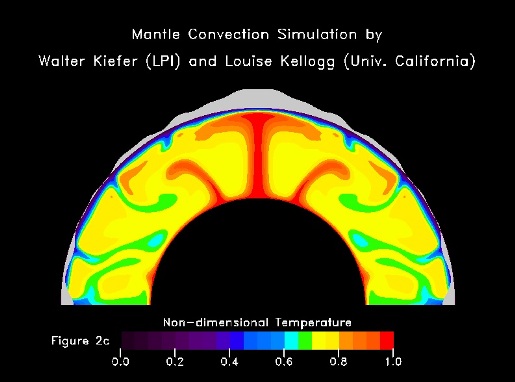
Professor Philip Allen* attends a multidisciplinary meeting about bulges, blobs and burial
Geoscientist Online Special 12 October 2011
Seldom does anything that appears at the time to be common sense turn out to right. The age of the Earth (surely not); plate tectonics (how absurd); relativity (you must be joking) and quantum physics (surely you don’t expect me to believe that?).
We are used to surprises, especially in geosciences, whose practitioners have been, as Tennyson put it, “nourishing a youth sublime, with fairy tales of science, and the long result of Time”. Now we are getting used to the idea that the deep, slow flow of the mantle is manifested in the ever-changing topography of the Earth’s surface.
This was the theme of a conference held at Burlington House (1-2 September 2011) entitled ‘Dynamic Topography: A key surface record of deep Earth processes’, and convened by Roderick Brown assisted by Patience Cowie, Stewart Fishwick, Gregory Houseman, Michael Kendall and Nicky White. The meeting attracted the great and the good from the worlds of geodynamics and seismology, with a smattering of tectonics experts, thermochronologists, sedimentologists and geomorphologists. The mix was vibrant, and I have seldom enjoyed more such animated discussions.

For more information relevant to the image on the right please click here
SPECTACULAR
The spectacular 3D images of minute but highly significant density differences observed from mantle tomography (thought to be mostly generated by temperature variations) combined with experiments and theory that show that the Earth must be convecting, lend support to the idea that the effects of mantle flow may be transmitted upwards to the Earth’s free surface. But the enduring problem is that processes operating within the outer cooled thermal boundary layer of the Earth (aka the ‘plates’), as they career around the Earth in relative motion, also generate topography; which is why the Himalayas have snow on them. Conference participants spent a good deal of time discussing how we disentangle these two effects, one emanating from the deep, and the other from the plates.
This may surprise you but I am often asked “What actually is ‘Dynamic Topography’”? My short reply runs something like: “It’s the vertical displacement of the Earth’s surface generated in response to flow within the mantle” 1. These words seldom placate the enquirer, and I am starting to realise why. For after two days of pleasant incarceration in Burlington House, I discovered that the experts were not exactly singing from the same hymn-sheet.
For more on the image (right) click here
BLOB
When gravity acts on density differences it produces a force known as buoyancy. Gravity acting on a hot air balloon relative to a cool outside atmosphere causes a positively buoyant force that makes the balloon rise. Now imagine a source of buoyancy deep in the Earth caused by the presence of a less dense lower layer beneath a more dense upper layer. The lower layer wants to bulge upwards caused by its positive buoyancy. Viscous stresses transmit this upward acting force, which is opposed and balanced by gravity acting on the upwardly deflected surface. The positive ‘blob’ of buoyancy is counterbalanced by the negative buoyancy of the upwardly deflected bulge. The source of the density difference promoting buoyancy may ultimately be caused by flow, and the blob of buoyancy may well be moving, causing a dynamic response by the resistance of the surrounding viscous material, but dynamic topography is calculated at an instant in time as simply a static balance between the buoyancies of the blob and the deflected surface that it generates.
If we wanted to calculate the dynamic topography from a known internal distribution of buoyancy, we would need to know the distance of the ‘blob’ from the Earth’s surface and the viscosity of the intervening material. This is why if we could accurately measure dynamic topography, it would help in the assessment of the viscosity structure of Earth’s mantle, a kind of Holy Grail for the geodynamicists at the meeting.
There are therefore problems in recognising what is dynamic topography and what is not, and difficulties in understanding how deep flow of the mantle is transmitted to the surface through the filter of the plates. What seemed like an innocent phrase, ‘Dynamic Topography’ turns out to be elusive to measure, problematic to model, and perhaps even ambiguous to define.
After scientific conferences, thoughts commonly slowly crystallise from the heady cocktail of talks, posters, discussion sessions and chance conversations. As a non-specialist who dabbles in other people’s business, I became increasingly convinced that ‘dynamic topography’, as a term, needs review. For essentially, the topography referred to is not truly dynamic, in the sense of, for example, the surface elevation changes associated with the great currents of the ocean such as the Gulf Stream2 . It is more strictly a ‘buoyancy-related topography’ originating deep in the Earth below the surface plates, where the spatial patterns and magnitudes of the buoyancy are primarily caused by a very slow circulation.
Whatever we call it, there was a consensus at the conference that this is a field of enquiry that brings benefits whether you are looking downwards or upwards. Looking downwards, it has the potential to better constrain the Earth’s viscosity structure. In addition, the record of dynamic topography over geological time periods provides a ‘narrative’ that allows the tempo of change in the mantle to be better appreciated, thereby aiding an understanding of internal dynamics in general. Looking upwards, mantle flow gathers the continents into supercontinental assemblies, heats them up and causes them to disperse.
At a less grand scale it may explain the ups and downs of continental interiors. Dynamic uplift may cause rivers to react by etching new drainage networks or reinvigorating old ones. Dynamic subsidence causes basins to sag. It is probably the main factor in controlling the inundation of continents from which the history of global sea level is calibrated. In the ocean, dynamic topography may cause gateways and barriers to open and close, affecting ocean circulation and driving climate change. The melting associated with hot regions in the mantle immediately beneath the plates is responsible for massive outpourings of volcanic rocks that have been implicated in the occurrence of mass extinctions.

For more on the above image, click here
WITCH’S CAULDRON
The slowly circulating witch’s cauldron deep beneath our feet therefore plays an important role in a wide range of Earth processes today, just as it has in the past. It is fitting that the Geological Society conference took place 100 years after the paper by a young Arthur Holmes, who dated a rock using a radiometric clock. Holmes was to later recognize that that same radiogenic decay produces heat that underpins the mantle circulation. Holmes would be pleased, I am sure, at the surge of interest in Dynamic Topography, and the organizers and participants are to be congratulated on this most stimulating of conferences.
Philip Allen is at the Department of Earth Science & Engineering, Imperial College London
FOOTNOTES
- This definition more or less follows Richards, M.A. and Hager, B.H. (1984) Geoid anomalies in a dynamic Earth. Journal Geophysical Research, 89, 5487-6002, though the term was coined earlier.
- Currents set up in the ocean are deflected by the effects of the Earth’s rotation, causing the surface of the ocean to be tilted. The Gulf Stream is an example. This is a true ‘oceanographic dynamic topography’ since the inclination of the sea surface is strongly affected by the velocity of the current.